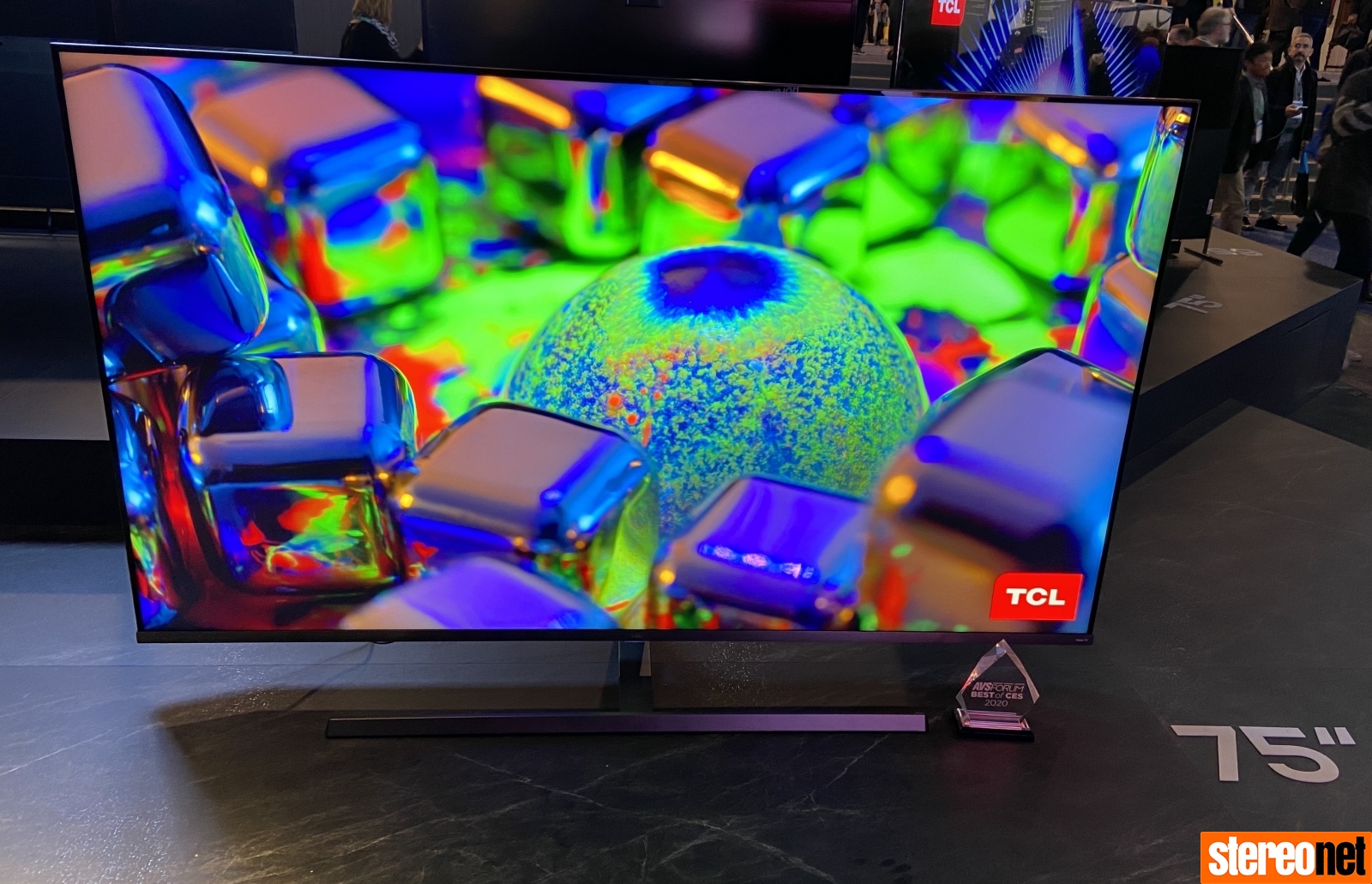What CES 2020 taught us about the future of TV

The new decade may only be a few days old, but it’s already brought us a dazzling parade of new technology courtesy of the 2020 Consumer Electronics Show in Las Vegas. And as usual, TVs were among the hottest CES tickets, providing much of the most exciting - and controversial - news.
The single biggest TV story was the rise of 8K. This sees TVs squeezing 7680x4320 pixels into their screens rather than 4K’s 3840x2160 pixels, delivering four times as much resolution. Almost all the leading TV brands had some new 8K screens to share, with some - most notably Samsung and LG - announcing multi-tiered 8K ranges for 2020.
What’s more, in the vast majority of cases the 8K screens on show are actually coming to market in the next 12 months; they’re not just concept/prototype models.
They are, though, inevitably premium sets that sit at the top of most brands’ 2020 TV ranges. In other words, they won’t come cheap. That said, Samsung revealed that the most affordable models in its new 8K range will replace its previous flagship 2019 4K Samsung QLED TVs, suggesting that they will be available for more or less the same price (the 65-inch 65Q90R launched at just over AUD $4,874).
Many of the new generation of 8K TVs looked dazzlingly good in both picture quality and design terms. There was also, however, plenty of controversy surrounding the rise of 8K at CES. Most of it centred around the argument that nobody needs an 8K TV as there’s currently practically no native 8K content available.
While it’s true there’s precious little native 8K content, though, the 8K haters ignore a couple of key facts. First, sales trends show that more and more of us are looking to buy huge TVs - 75 inches and more. And when you’re talking about screens as big as that, resolution becomes increasingly important to picture quality.
This is due to the so-called pixels per inch effect, where the more pixels a TV has for every inch of its screen, the sharper and more natural its pictures will look. In other words, a 40-inch 4K TV’s picture will look sharper than a 55-inch 4K TV’s picture. So if you want a 75-inch TV’s picture to look as sharp as a 40-inch 4K TV’s picture, you’re going to need to increase its resolution.
The other significant factor 8K detractors ignore is the massive improvement in upscaling technology 8K is bringing with it. Last year’s 8K TVs came with upscaling powered by ‘AI’ and machine learning, delivering some remarkable results. At least when upscaling 4K to 8K. And this year the leading brands - but especially Samsung - are adding deep learning algorithms to their upscaling systems, enabling them to work more effectively in upscaling the most detailed parts of sub-8K sources.
Obviously, we’ll need to spend more time with the 2020 8K TVs to confirm how well the latest upscaling engines are working, but early indications are very promising.
Micro-LED

For the third CES running, Samsung used its big ‘First Look’ CES showcase event this year to go big - literally - on micro-LED screens. It even showed a 292-inch model with an 8K resolution.
This opening micro-LED salvo was eye-catchingly followed on the show floor by micro-LED prototypes from, among others, LG and TCL. Sony was also wowing crowds with its similar Crystal LED technology.
Micro-LED screens are exciting because they use tiny self-emissive LEDs to produce pictures that can deliver levels of contrast, brightness and colour range far beyond the capabilities of current screen technologies. And because they don’t use any organic elements, they don’t suffer with image retention problems like OLED TVs can.
What’s more, since micro-LED screens are currently made by joining together small ‘blocks’, it’s possible to build displays to almost any shape or aspect ratio.
CES 2020 marked, though, the third consecutive year Samsung has shown micro-LED screens. Yet while it is at least now possible to buy a few (huge) versions of Samsung’s ‘Wall’ micro-LED screen, ongoing problems with achieving mass production mean they still cost hundreds of thousands of pounds. Ouch.
Rumour has it that a 75-inch ‘Wall’ might be available for formal review at some point in 2020. But no date - or price - for this more manageable micro-LED option has been confirmed.
The bottom line is that it still feels as if we’re another three or four years away at least from micro-LED becoming a realistic option for people who aren’t millionaires.
Mini-LED

Much more commercially viable than micro-LED is mini-LED. This is an advanced LED backlighting technology (rather than a truly new TV technology like micro-LED) where a TV illuminates its pictures using thousands, even tens of thousands of individually controllable LED zones.
I’ve seen one or two concept prototypes of mini-LED screens over the years, but TCL has become the first manufacturer to make it a consumer reality. In fact, its 8 series mini-LED debutantes last year offered the technology while costing less than the normal LED Backlight flagship models from some more established brands.
TCL announced at the CES 2020 that it’s going to be launching a new, 8K-friendly version of mini-LED on a new 8 Series range in the latter half of 2020. Called ‘Vidrian’, this new mini-LED technology places tens of thousands of separate LEDs onto a glass substrate, potentially introducing new levels of brightness, backlight accuracy, contrast and colour performance for LED screens.
The samples on show at CES were in quite an early stage of development, and so TCL couldn’t confirm just how affordable its 8K Vidrian sets might be. There were one or two issues with its pictures at this early stage in the sets’ development, too. But as TCL was keen to stress, there’s plenty of time before the finished TVs go on sale for the Chinese brand to improve their picture tuning.
ATSC 3.0 tuners
So far, 4K and HDR have belonged almost exclusively to the worlds of streaming, physical media and (usually subscription) satellite broadcasts. However, a new broadcast standard, ATSC 3.0 (also known as Next Gen TV) is finally going to arrive in a few TVs in 2020, supporting such goodies as 4K, HDR, wide colour gamuts, high frame rates and even supplemental information. Even 8K support appears on the ATSC 3.0 road map.
LG has confirmed that ATSC 3.0 tuners will be built into many of its 2020 OLED TVs, while Samsung has confirmed that its 8K QLED TVs for 2020 will also get Next Gen TV support.
Of course, these lovely new tuners will also need to be fed ATSC 3.0 broadcast services. But these seem to be pretty imminent too - at least in the US, where no less than 40 stations have stated they will deliver ATSC 3.0 broadcasts before the end of this year.
The status of ATSC 3.0 broadcasts in other parts of the world, though, seems less clear.
Next-gen Designs

Every CES brings us a mix of weird and wonderful TV designs, and CES 2020 was no different. Samsung caused a big stir with both its new 8K Q950TS QLED and micro-LED Wall screens. The Q950TS, Samsung’s flagship TV for 2020, introduced a striking new ‘Infinity’ design that sports a frame so thin you really can’t see it from a typical viewing distance. The immersive effect this creates, as the picture just seems to be coming out of mid-air, is really pretty remarkable.
Samsung’s Wall Micro LED TVs, meanwhile, raise some interesting design possibilities for two reasons. First, since they’re built from smaller blocks, they can potentially be made to any size and shape you like. Second, their software can run all sorts of different picture in picture options, enabling you to, say, display photographs and paintings in some areas, while a live TV area takes up another section of the screen. And you can effortlessly rescale any of these windows so that they take over the whole screen as and when required. In other words, micro LEDs can essentially replace your real wall with a digital one.

Elsewhere, LG followed up the startling roll-up OLED TV it caused such a stir with in 2019 with a new roll-down prototype. In fact, the front of its CES stand featured roll up and roll down OLED TVs moving to meet each other in one of CES’s most dramatic displays.
While the roll-up TV is finally coming to market (for tens of thousands of pounds), LG doesn’t seem likely to sell the 65-inch roll-down screen. For the simple reason that it doesn’t think 65-inches is big enough to cater for the replacement-for-a-projector market, such a screen would most appeal to.
LG Display, meanwhile (not to be confused with LG Electronics) was showing an OLED screen that can bend in and flatten out again at the press of a button, depending on whether you want a wrap-around effect (for gaming, say), or a flatter look for family viewing. This is just a prototype at the moment and may prove too expensive to become a viable living room technology. But you never know!
LG Electronics is also bringing to market in 2020 a new Gallery GX OLED design (in place of 2019’s E series) intended to try and capture some of the design splendour of the extraordinary paper-thin W series of OLED TVs it’s included at the top of its OLED range for the past three years. The GX series is extremely thin, features sophisticated connection and cable management options, and ships with a clever wall mount that lets the screen rest flush to your wall.
Gaming features

With the PS5 and Xbox Series X consoles due to launch in 2020 and PCs pushing ever forwards with their graphical capabilities, TVs are increasingly being used as high-end gaming monitors. So it’s no surprise to find TVs introducing more and more features to take advantage of this.
Samsung was the first brand to introduce support for variable refresh rates using the G-Sync system, and this continues into 2020’s range, along with automatic game mode switching, and an exclusive mode for making dark areas look brighter (without affecting the bright areas) to make enemies in dark areas easier to see. Plus Samsung has now got its input lag down to under 10ms in Game mode, as well as keeping it to just 21ms if you engage a new gaming motion mode that makes pans and in-game motion smoother.
LG, meanwhile, continues to support NVIDIA’s G-Sync adaptive frame rate system, as well as adding a new ‘HGiG’ (HDR Gaming Interest Group) mode designed to deliver a better, more consistent HDR gaming experience.
One other interesting gaming development came from TCL, which announced the world’s first TV THX Gaming Mode. A Game mode, in other words, that has survived THX’s stringent, independent tests to deliver a more effective gaming image.
Filmmaker Mode and Dolby Vision IQ

TVs in 2020 want to make it easier than ever for you to watch content the way the content creators intended it to look.
First, LG, Samsung, Panasonic, Vizio and Philips/TP Vision have all signed up to support the Filmmaker Mode - a Hollywood-led innovation that deactivates most of your TV’s video processing features (especially any motion smoothing systems) in a bid to deliver the purest picture possible.
Panasonic took things a step further by combining its Filmmaker Mode with a light sensor so that the Filmmaker mode can adjust its output based on the light conditions in the room.
Dolby, meanwhile, introduced Dolby Vision IQ. This combines Dolby Vision’s extra scene by scene image data with, again, the light sensors TVs use, joining Panasonic’s version of the Filmmaker Mode in recognising at last that HDR watched in a bright room can often look too dark.
The Chinese Are Coming
One final key TV trend from CES 2020 is the rising influence of Chinese brands. TCL already ascended to number two brand by volume in the US in 2019, and looks set to continue its meteoric rise on the back of an ambitious but likely still aggressively priced 2020 range - including those mini-LED models mentioned earlier.
Hisense did its usual job of combining lots of cutting edge TV technology at CES 2020 with more really strong value ‘core’ products. And most intriguingly of all, two relatively new Chinese brands, Konka and Skyworth, unveiled plans to make inroads into the US TV market with ambitious new OLED, QLED and 8K TVs.
Whether there’s really enough space in the TV market for these newcomers to succeed remains to be seen. But I suspect that while established giants such as Sony, LG and Samsung certainly put on quite a show at the CES 2020, they’ll all be starting the year looking nervously over their shoulders at what the relatively new Chinese rivals might be able to do.
John Archer
I’ve spent the past 25 years writing about the world of home entertainment technology. In that time I’m fairly confident that I’ve reviewed more TVs and projectors than any other individual on the planet, as well as experiencing first-hand the rise and fall of all manner of great and not so great home entertainment technologies.
Posted in:Visual Technology
Tags: ces2020
JOIN IN THE DISCUSSION
Want to share your opinion or get advice from other enthusiasts? Then head into the Message Forums where thousands of other enthusiasts are communicating on a daily basis.
CLICK HERE FOR FREE MEMBERSHIP
applause awards
Each time StereoNET reviews a product, it is considered for an Applause Award. Winning one marks it out as a design of great quality and distinction – a special product in its class, on the grounds of either performance, value for money, or usually both.
Applause Awards are personally issued by StereoNET’s global Editor-in-Chief, David Price – who has over three decades of experience reviewing hi-fi products at the highest level – after consulting with our senior editorial team. They are not automatically given with all reviews, nor can manufacturers purchase them.
The StereoNET editorial team includes some of the world’s most experienced and respected hi-fi journalists with a vast wealth of knowledge. Some have edited popular English language hi-fi magazines, and others have been senior contributors to famous audio journals stretching back to the late 1970s. And we also employ professional IT and home theatre specialists who work at the cutting edge of today’s technology.
We believe that no other online hi-fi and home cinema resource offers such expert knowledge, so when StereoNET gives an Applause Award, it is a trustworthy hallmark of quality. Receiving such an award is the prerequisite to becoming eligible for our annual Product of the Year awards, awarded only to the finest designs in their respective categories. Buyers of hi-fi, home cinema, and headphones can be sure that a StereoNET Applause Award winner is worthy of your most serious attention.









